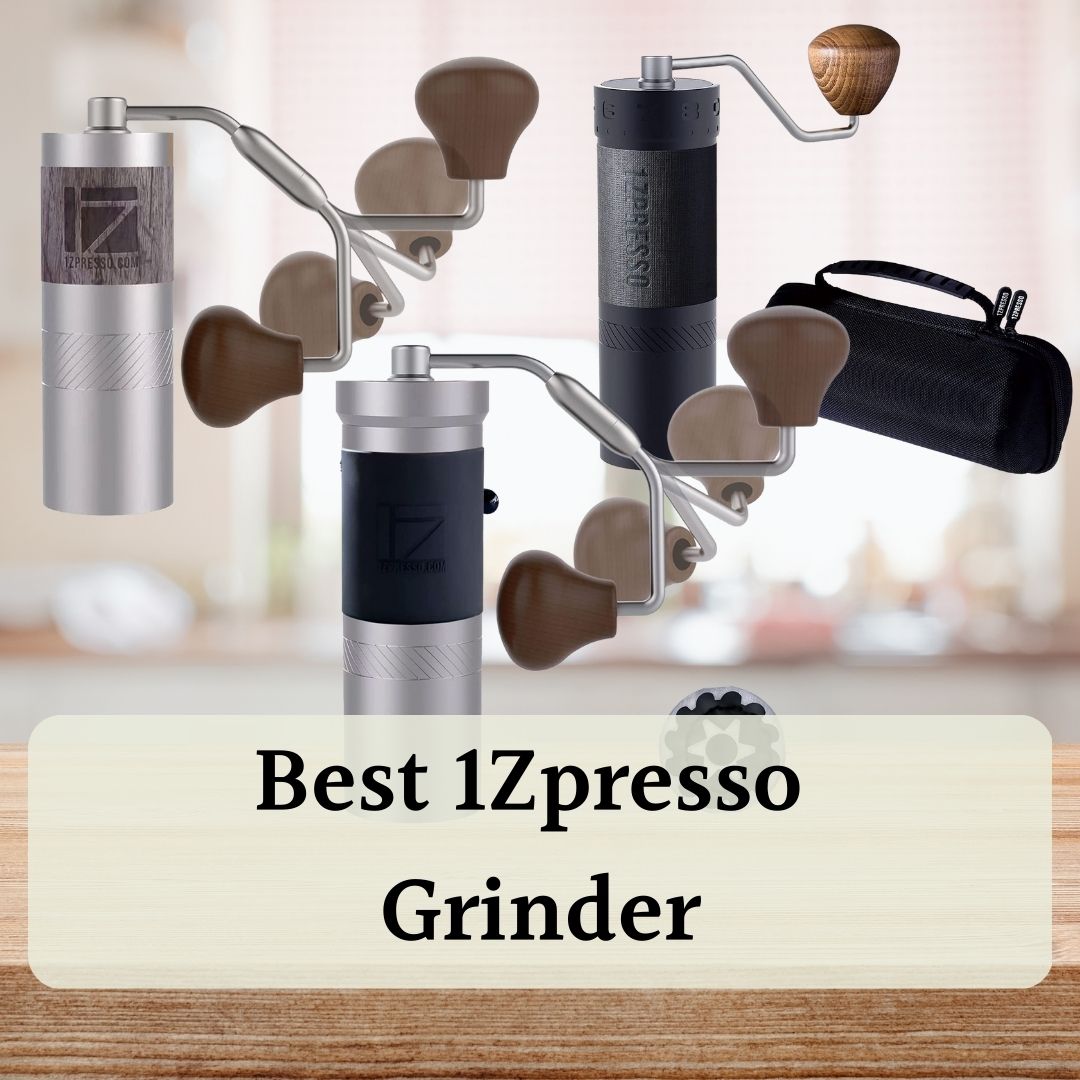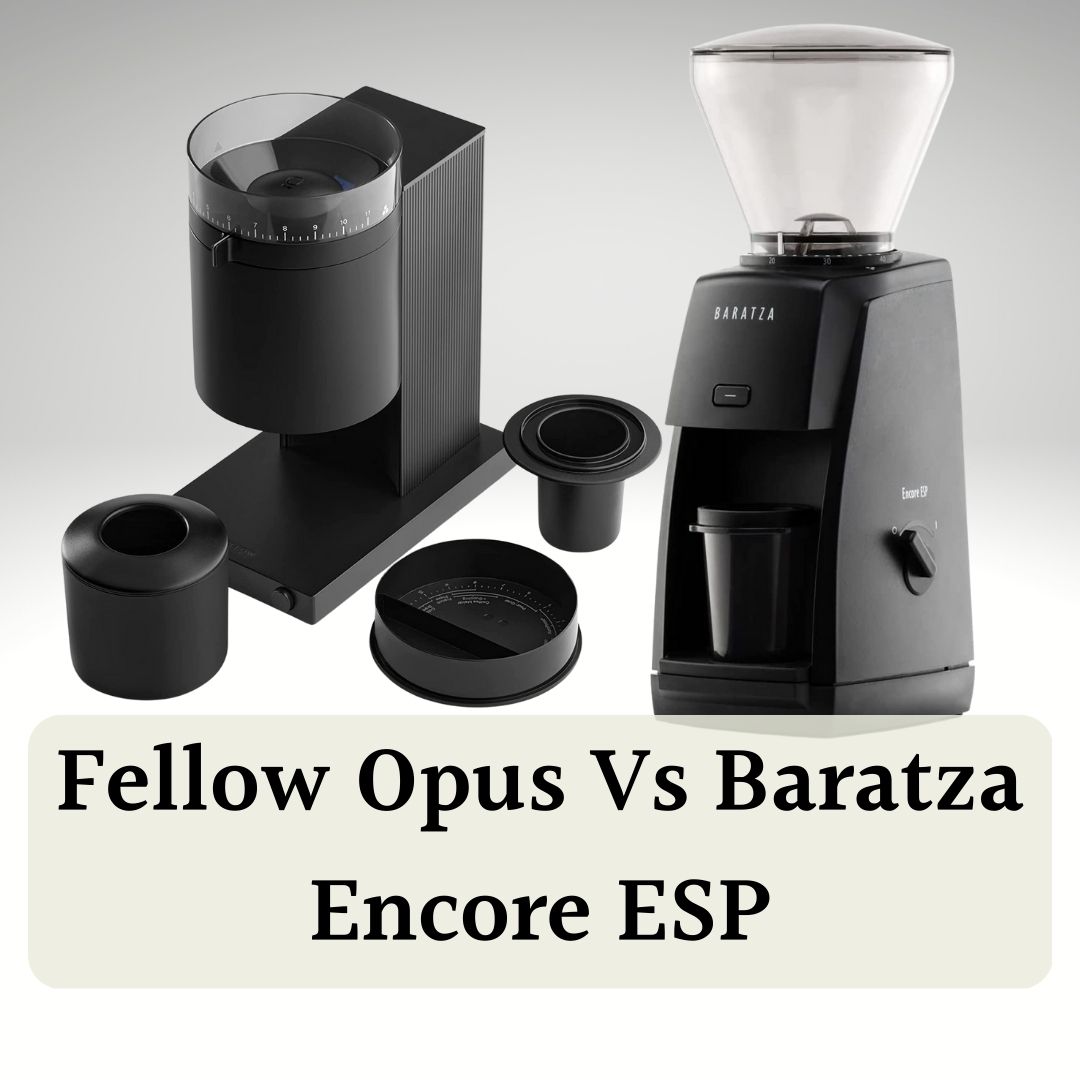The time has come to raise your coffee game to the next level. You’re ready to say goodbye to your blade grinder and invest in a burr one.
The top three burr grinders best suited for beginners are Baratza Encore ESP, Fellow Opus, and Breville Smart Grinder Pro. Why choose these three? Because they all grind for a range of brew methods, are intuitive, and come at reasonable prices. These grinders will improve your coffee immediately, whether its pour over, espresso, or French press.
I’ll explain why these three burr grinders are the perfect blend of functionality, affordability, and ease of use. But that’s not all. I’ll give you a list of seven options for the best coffee grinder for beginners, including a comprehensive buying guide, so you can easily choose the grinder that’s a perfect fit for your coffee needs.
What to Consider When Buying Coffee Grinders
You should use a burr grinder and grind just before brewing. This single change will improve your coffee.
Grinder type: Burr Grinders vs. Blade Grinders
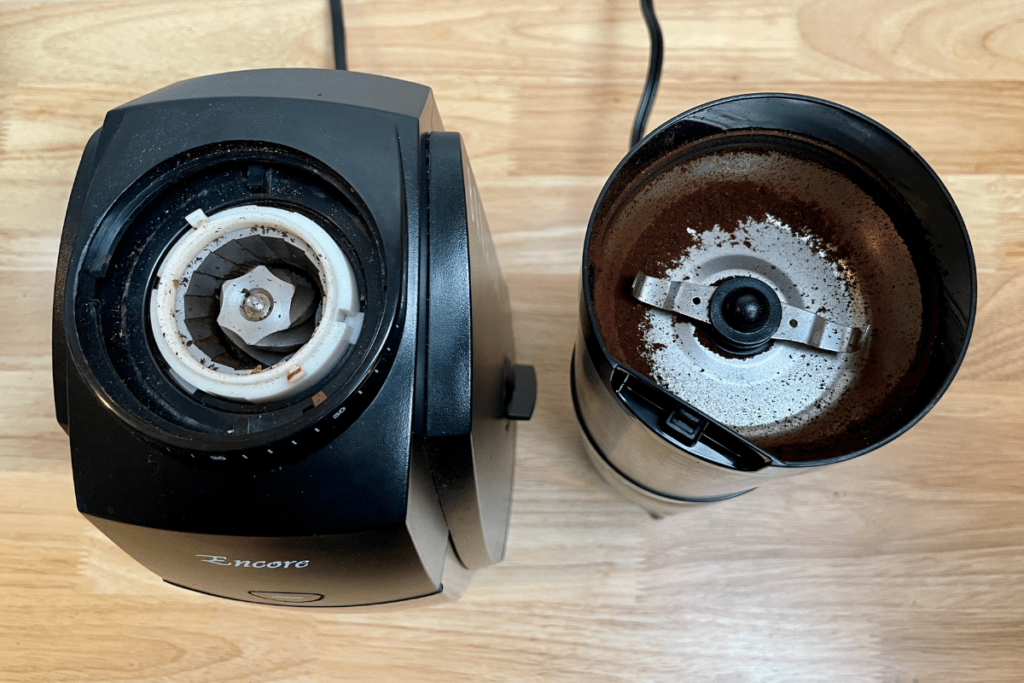
Blade grinders have a spinning blade that chops the coffee beans into small particles. These grinders are often more affordable than burr grinders, so they are an attractive option for barista beginners on a budget. Blade grinders are also easy to use. Usually, you press a button to start the grinding process. However, blade grinders have several drawbacks.
Blade grinders produce inconsistent grind sizes. You get a mix of fine and coarse grounds. Inconsistent grounds lead to uneven extraction, which means a less balanced and flavorful cup. There’s also no grind setting on a blade grinder. You just hold the button down until you think you’ve reached the grind size you want. Moreover, blade grinders tend to generate heat during the grinding process, which causes the coffee beans to lose some freshness in their flavor.
Burr grinders have two abrasive surfaces, called burrs, which crush the beans between them into uniform particles. You can change settings by moving the burrs closer together or farther apart, giving these grinders a wide range of grind size options. With a burr grinder, you can customize the coarseness to your preferred brewing method (fine for espresso, coarse for French press, etc.).
Burr grinders create consistent grind size, which means even extraction and a nuanced flavor profile in your cup. Finally, burr grinders generate less heat during the grinding process, which preserves coffee beans aromas. The main downside of burr grinders is that they are often more expensive than blade ones.
To sum up, while blade grinders are cost-effective and convenient, they fall short in grind consistency and overall coffee quality. My advice is to invest in a burr grinder to elevate your brewing game and get the most out of your coffee beans.
Burr Type
I’ve shown why burr grinders are better than blade grinders. However, there are two kinds of burr grinders: conical and flat burrs.
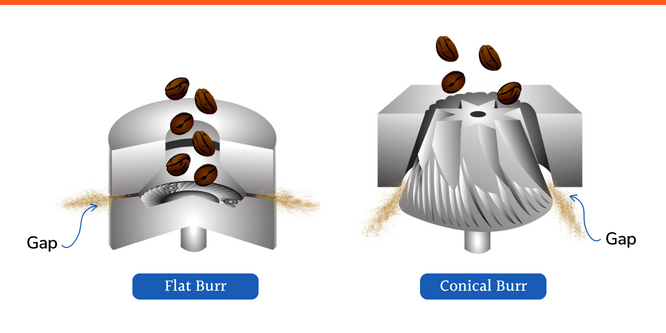
Conical burr grinders use gravity to draw coffee beans down between two cone-shaped burrs. In this setup, one burr spins, and one burr is stationary. Conical burrs can produce a wide range of grind sizes, so they are versatile and can be used for different brewing methods. These burrs produce less heat during the grinding, which is good for preserving flavors. Finally, they need less maintenance, so they are a good choice for beginners who want convenience.
Flat burr grinders have two flat, parallel discs, and the beans pass through them during the grinding. They have longer contact with the burrs, which results in a more consistent grind. Unlike conical burrs, which rely on gravity, flat burrs use a high-speed motor to spin fast enough that grounds are pushed out of the burrs. These grinders are great for espresso because they create excellent grind consistency. However, they need more cleaning and calibration than conical burrs. Flat burr grinders also have worse grind retention than conical burr grinders since gravity isn’t helping move grounds through the burrs.
Neither burr type is inherently better than the other. Each has different use cases that work for different setups, so the choice between the two depends on your specific needs.
Another consideration is the burr material. You can choose between stainless steel and ceramic burr grinders. Stainless steel burrs are durable and affordable. Ceramic burrs have better heat resistance and stay sharper for longer. However, ceramic burrs are more brittle and easily damaged.
Overall, there’s no definite answer on whether ceramic or steel burrs are better. Ceramics last longer if undamaged, but you’ll also be able to grind hundreds of pounds with stainless steel before needing replacement, so for a home setup, the differences are minor.
Use Cases and Grind Settings
You need a grinder that will work for your preferred brewing method. Brewing methods have different grind ranges and certain grinders work better for those.
Here is what you should think about, going from fine to coarse grind sizes.
- Espresso — Requires fine and very consistent ground coffee to create good extraction under pressure, as small inconsistencies will have a big impact on taste. You should also have a grinder with a range of micro settings to dial in.
- AeroPress — Can work with various grind sizes, but a medium-fine is often recommended for the best flavors.
- Drip coffee — You need a medium grind for drip machines, which should resemble coarse sand for a balanced extraction. This way, the water can flow through the coffee at a rate that creates a well-rounded cup.
- Pour over – the grind size can range from medium-fine for a flat bottom dripper to medium coarse for Chemex. The key is consistent grind size to emphasize the clarity that pour overs are known for.
- French Press — Needs a coarse grind to prevent over-extraction and sediment in the cup. Coarse grind also needs a longer steeping time. The grounds should have a consistency that resembles breadcrumbs or coarse salt.
- Cold brew — Needs a very coarse grind because this method requires a long steep time. This is even coarser than the French press, and the coffee particles almost look like gravel or small pebbles.
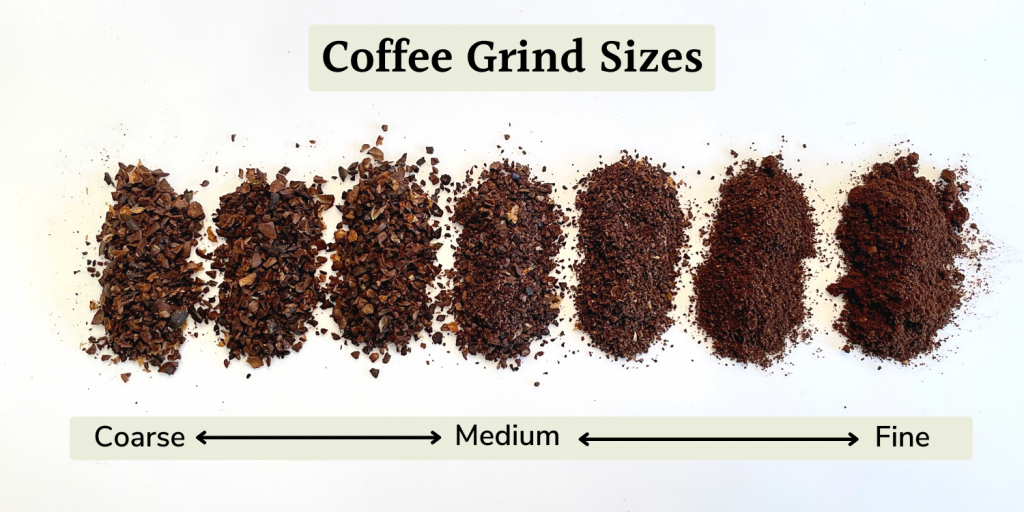
If you plan to use a grinder for various brewing methods, you need one with a wide range of grind settings. Coffee grinders can have two ways of adjusting grind settings: stepped and stepless. With a stepped burr grinder, the grinder has definite stops with preset distances between the burrs that you select from.
A stepless grinder has no preset distances between the burrs. Turning the adjustment dial is like tightening a screw that gradually moves the burrs closer together. In other words, there are no stops, and a stepless grinder has an almost infinite amount of settings.
Stepless grinders are ideal for espresso. You can experiment until you find out your preferred grind setting. Nowadays, many stepped grinders can also do espresso well. They have adjustment steps in the fine espresso range or micro-adjustments that let you have a high level of control over the grind.
For other brewing methods, stepped dosing is perfectly fine and much easier to use. I recommend a grinder with at least 20 settings to get enough control over your grind size. The more settings, the better.
Convenience and Noise Level
Different types of coffee grinders hugely vary in their ease of use. Regarding convenience, manual grinders are compact, portable, and don’t need electricity. They are a great option if portability is important to you. However, a manual coffee grinder needs physical effort and can take longer to grind.
Electric grinders are easier to use. You push a button, and the grinder does the work. Plus, they are often quicker than manual ones. However, they are larger, so they will take up more of your counter space. Plus, they need electricity to run.
As for the noise levels, it’s determined by the material used for the grinder’s body, Revolutions Per Minute (RPM), and the burr geometry. Flat burrs use more RPM to ensure the beans are forced into and out of the grinding chamber. The powerful motors needed to reach that high RPM make a lot of noise.
A conical burr coffee grinder runs at a lower RPM and doesn’t need as powerful a motor, which means it’s less noisy than a flat burr grinder.
Of course, it goes without saying that a manual coffee grinder is much quieter than an electric one.
Budget
Conical burr grinders are usually more affordable, and you can find them for under $50 to several hundred dollars. Flat burrs are more expensive because they have more powerful motors. Their price goes from a few hundred dollars to over a thousand.
Also, manual coffee grinders are more affordable than electric ones. They don’t need electricity to run and have a simpler design, so they are a good budget-friendly option if you’re willing to invest time and effort to grind the beans.
This list focuses on grinders in the $100-300 range that can grind for various brewing methods. They will get you started easily without breaking the bank.
Individual Reviews: Best Coffee Grinder for Beginners
| Image | Product Name | Features | Price |
|---|---|---|---|
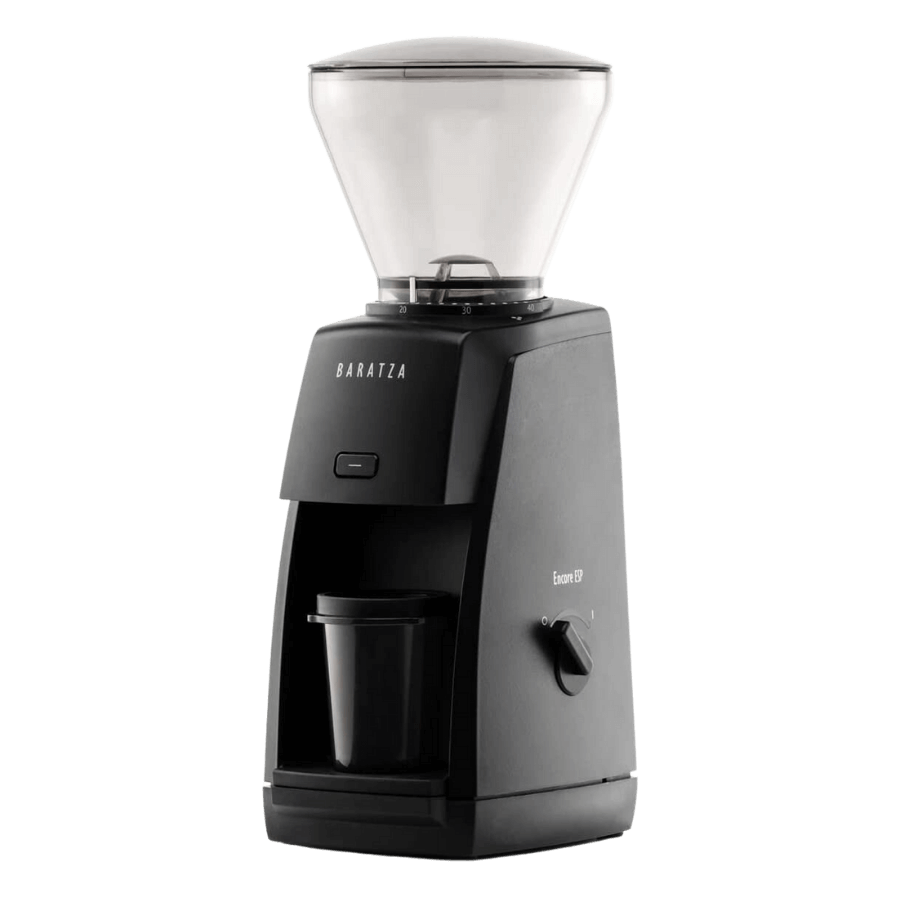 |
| Check Amazon | |
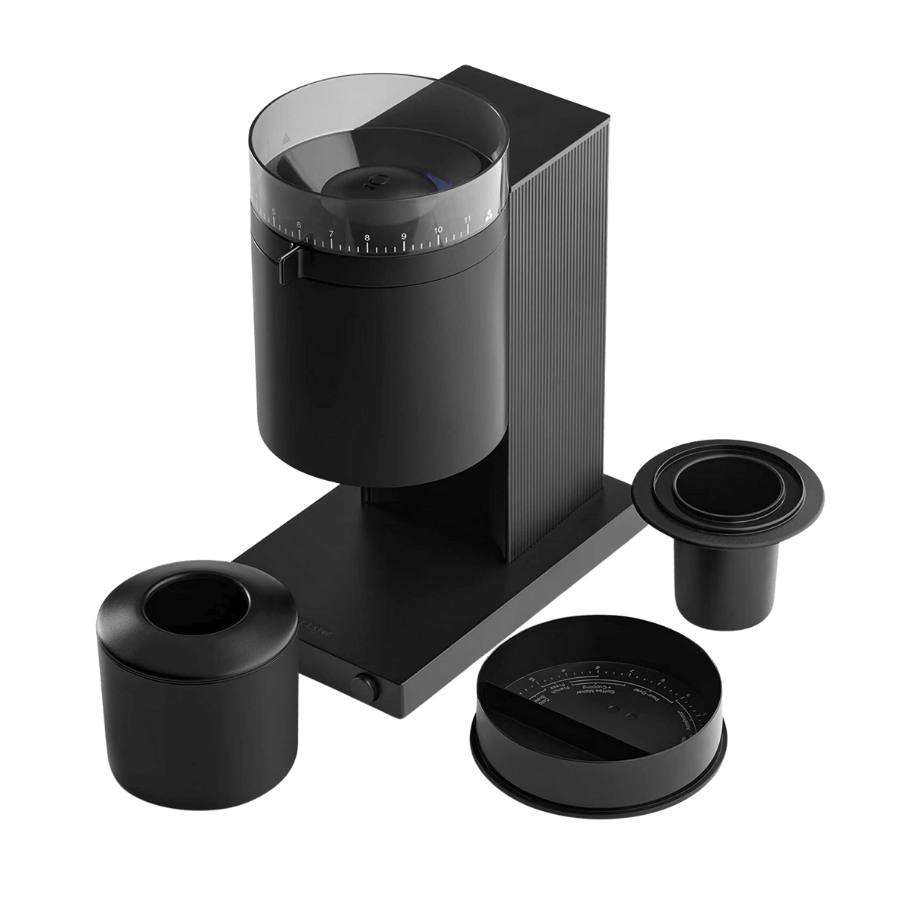 |
| Check Amazon | |
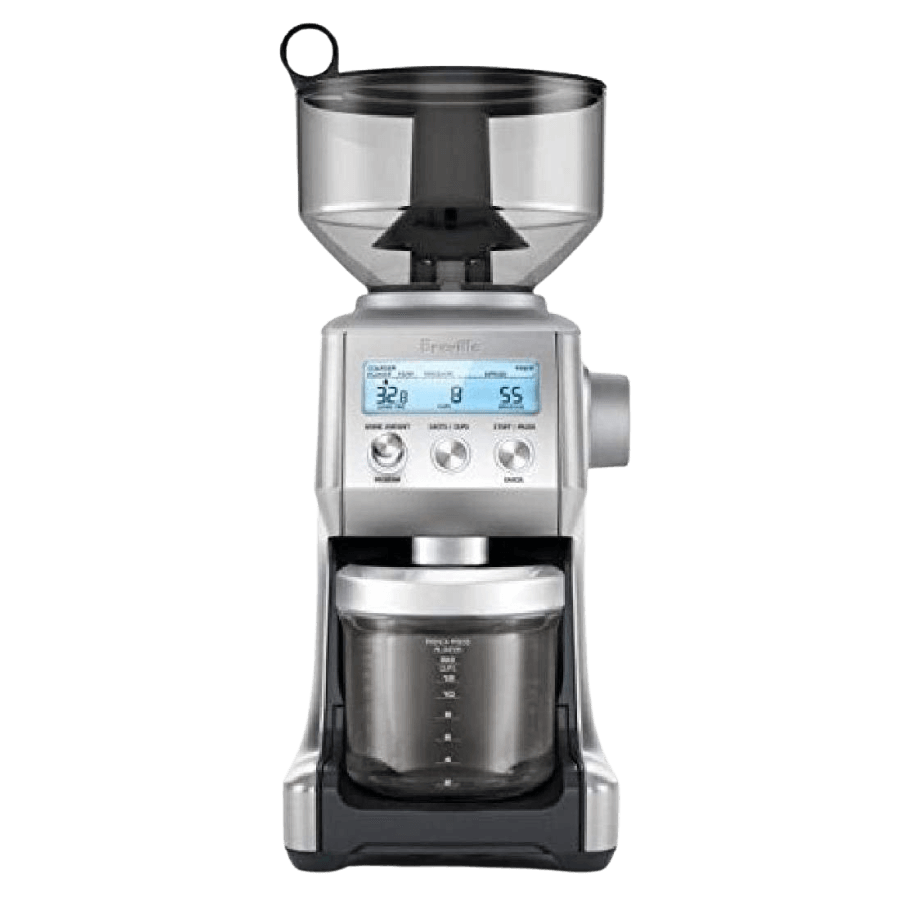 |
| Check Amazon | |
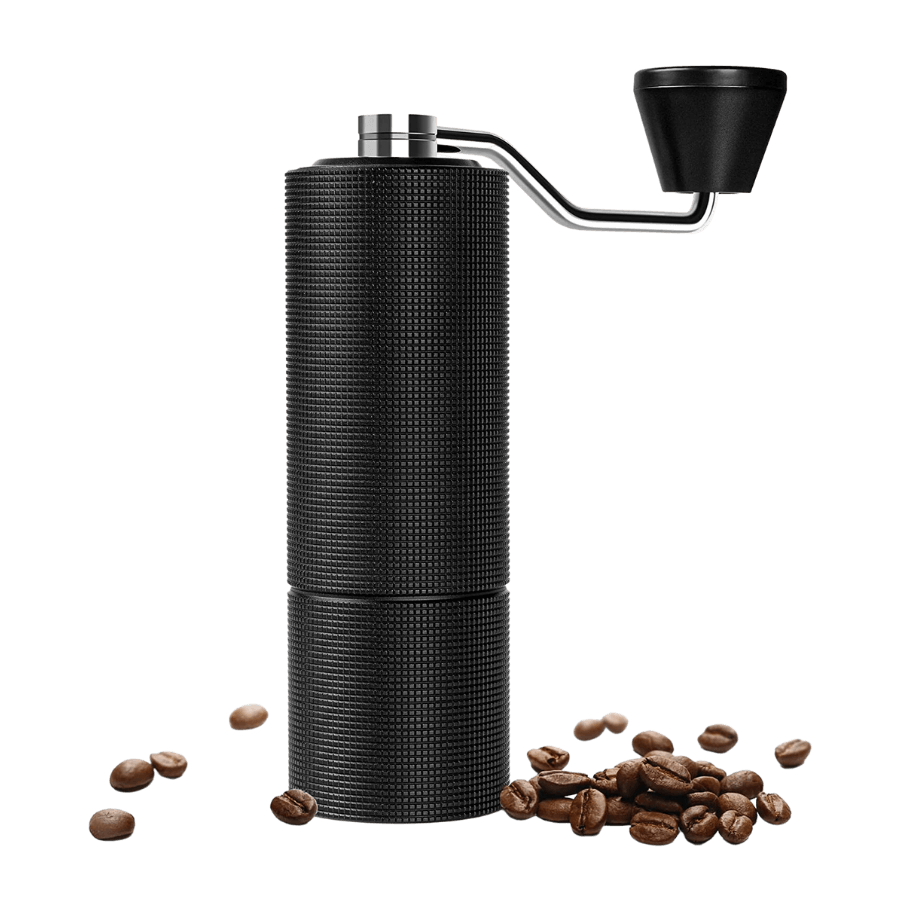 |
| Check Amazon | |
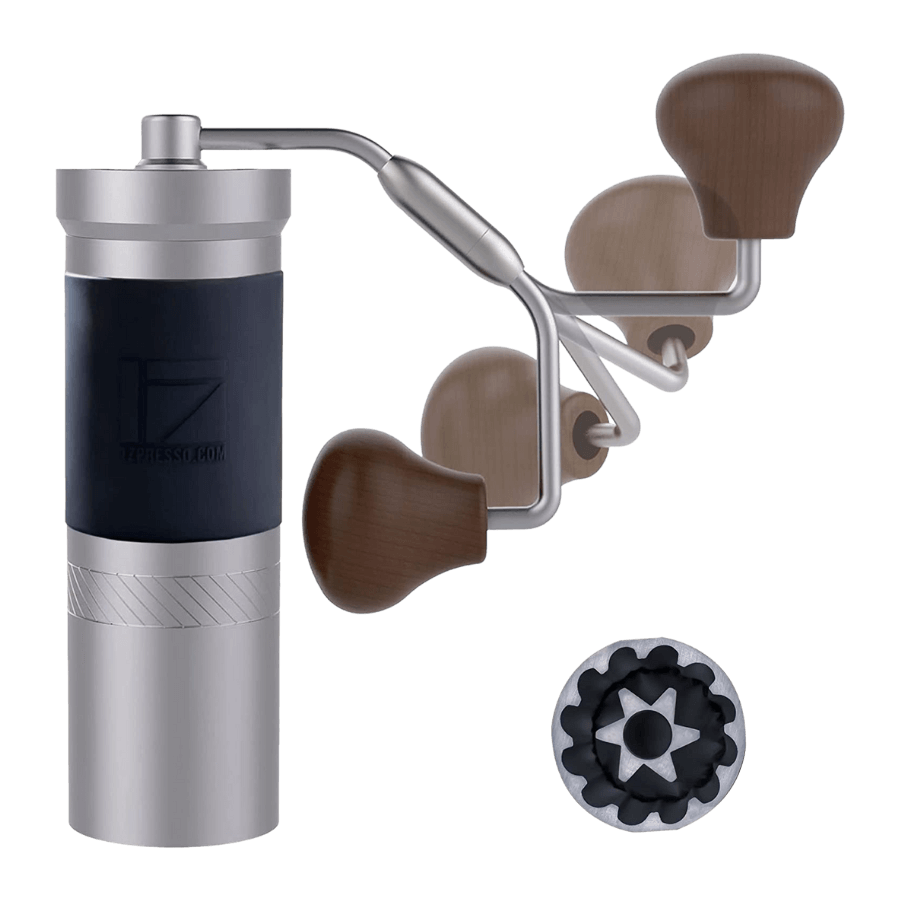 |
| Check Amazon | |
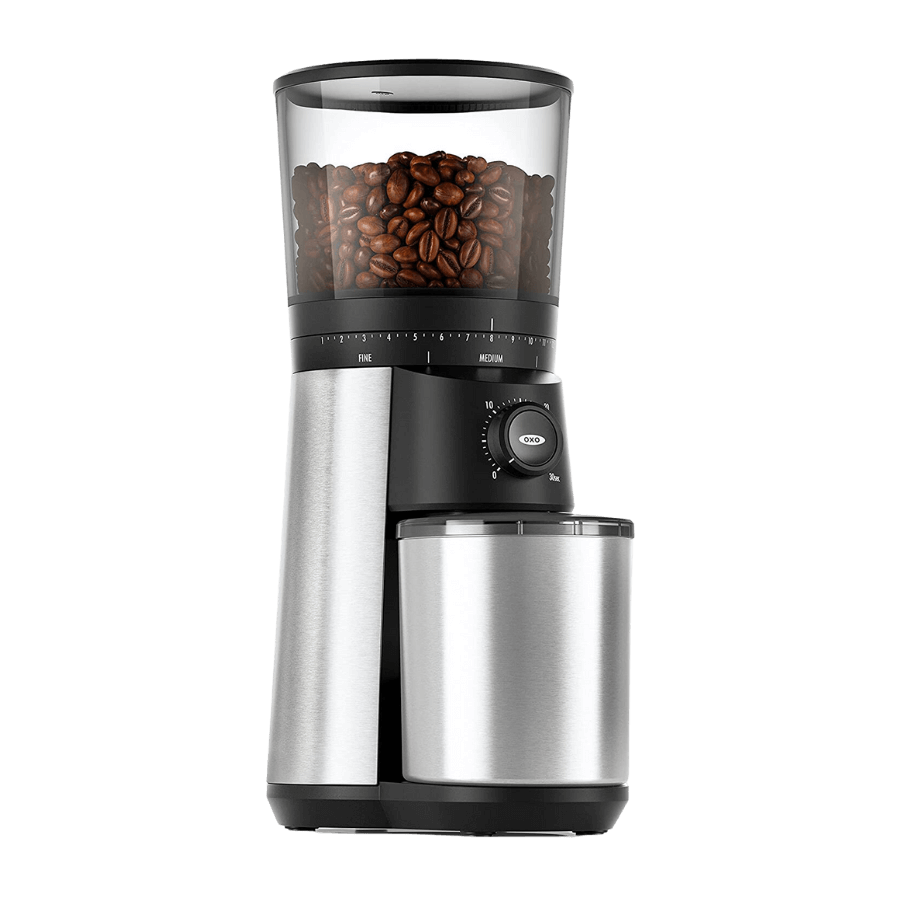 |
| Check Amazon | |
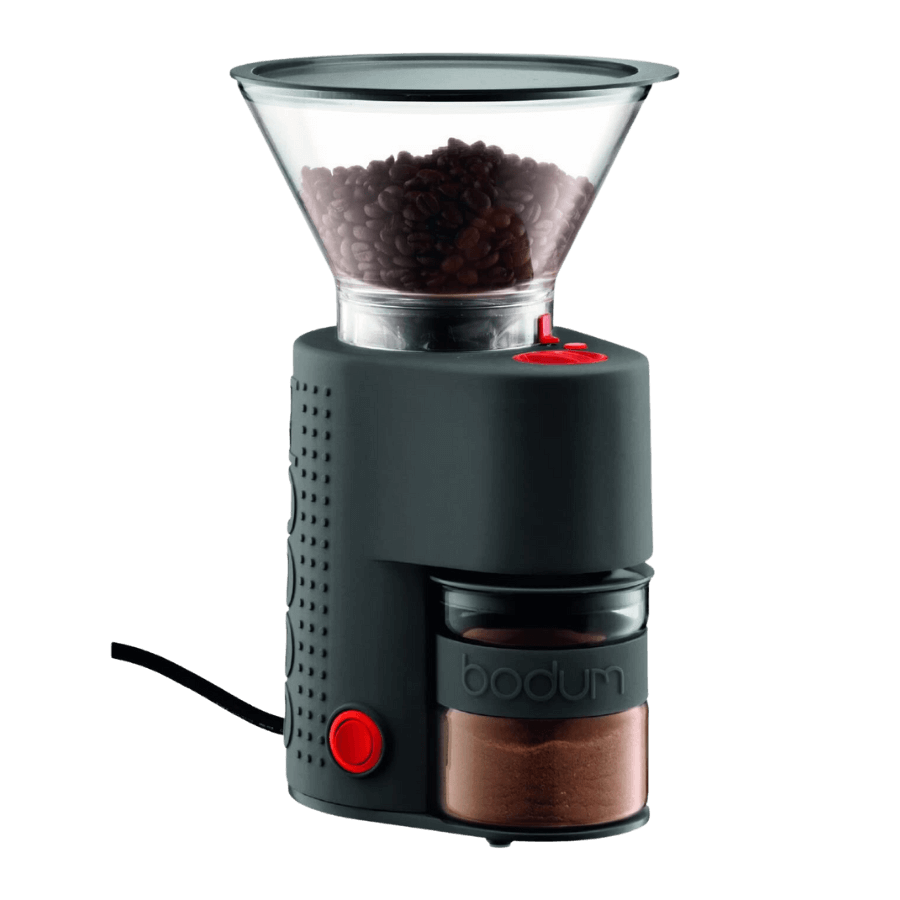 |
| Check Amazon |
1. Baratza Encore ESP

Baratza Encore ESP highlights:
- Burr type: 40 mm conical burrs
- Number of grind settings: 40 (20 fine micro-settings and 20 coarse macro-settings)
- A 54mm dosing cup makes it easy to transfer grounds directly into a portafilter.
Baratza Encore ESP is on the top of many coffee grinder lists, and I can see why. This is an upgraded version of the original Baratza Encore and improves on the Encore’s design with better espresso grind settings. It has a plastic build and a small footprint. There’s a 5 oz catch bin and a dosing cup. You can grind straight into the 54 mm dosing cup or add the adapter ring and make it compatible with a 58 mm portafilter.
The bean hopper’s capacity is 10 oz, so this isn’t a single-dose grinder. I also appreciated the adjustment collar and the base are metal, which improved the original model. It has a very simple, minimalistic design, but the build is durable, and this coffee grinder will last years.
Let’s get into the most important aspect of every coffee grinder: the burrs. Baratza Encore ESP has M2 40 mm conical steel burrs. M2 burrs produce consistent ground coffee with a few fines, which is great for espresso. The motor is a high-torque that spins at 550 RPM, making the Encore ESP a very noisy grinder.
The grind settings are easily adjustable. There are 40 settings, divided into two parts (fine settings that go from 1 to 20 and coarse settings from 21 to 40). This gives you the versatility needed to make pour-over and French press but also the precision needed to dial in espresso.
You can easily distinguish between the two setting ranges, as the threads are spaced further apart on the coarse ones and closer on the fine ones. Overall, you can easily make larger adjustments and make filter coffee or fine adjustments for espresso. Compared to some other coffee grinders, this system is impressively easy and intuitive.
Pros
Compact size
Easy to adjust grind settings
Magnetic catch cup or dosing bin
Cons
Noisy
Minimalist design with no extra features.
2. Fellow Opus

Fellow Opus highlights:
- Burr type: 40 mm conical burrs
- Number of grind settings: 41 base settings with additional micro adjustment dial
- Lid has measurements for brewing different kinds of coffee
The Fellow Opus is an affordable grinder that’s designed to be easy to use even if you don’t have much coffee experience. The first thing you’ll notice about this grinder is its stunning design. However, a closer inspection reveals the outside is completely made of plastic that’s prone to scratches, especially on the base and the hopper lid.
This coffee grinder has a magnetic catch cup that fits both 58 mm and 54 mm portafilters, so you can easily transfer the ground coffee. The hopper lid functions as a dosing cup with 20 g to 40 g compartments, but it can hold up to 110 g of coffee beans. This you can dose without a scale (I still recommend using a scale, as these measurements are a general guideline). Moreover, the lid shows the recommended grind settings for different brewing methods, which is a helpful tool for newbie baristas.
The Opus is a 40 mm conical burr grinder with a high torque motor that spins at 350 RPM. You’ll notice this is lower than the Encore ESP, so the Opus generates less heat and is quieter. This coffee grinder creates an even, consistent grind with no issues from me.
The Opus has 41 grind settings that range from 400 to 1500 microns, which means you can dial in and grind for pretty much every brewing method. Its fine settings can’t compete with grinders designed specifically for espresso, but it makes an enjoyable shot.
However, grind adjustments are complicated. The Opus has an additional set of micro settings for dialing in espresso. These settings are located on an inner dial under the hopper. These are somewhat difficult to get to and use. I won’t get into the nitty-gritty here, but you can check out our Baratza Encore vs. Fellow Opus comparison to learn more.
Pros
Attractive design
Grinds for all brew styles
Dosing lid fits 54 mm and 58 mm portafilters
Cons
100% plastic construction
Complicated micro adjustments
3. Breville Smart Grinder Pro

Breville Smart Grinder Pro highlights:
- Burr type: 40 mm conical burrs
- Number of grind settings: 60
- Time-based dosing presets
Breville Smart Grinder Pro is a versatile, capable grinder that provides a great user experience. The design is sleek and modern, with many user-friendly features built in. Its hopper fits up to 1 lb. of coffee, and the grinds are dosed into the dose bin or straight into the 54 mm portafilter.
This coffee grinder has two time-based dosing presets and 60 grind settings, from espresso to French Press. The dosing is very intuitive, as a simple side dial adjusts the grind setting. There’s also an LCD screen on the front, where you can always check the current setting. A display at the bottom of the screen lets you know which brew method is best for a certain grind setting (which beginners will find very useful). Overall, the use is easy, and you don’t need to study the manual intensely to start grinding.
The burrs are 40 mm stainless steel conical burrs. The coffee grinder isn’t as consistent as the above two electric coffee burr grinders. You’ll see some clumping, especially at the fine settings, and the coarse settings have visually noticeable inconsistencies.
Overall, it’s an affordable coffee grinder that’s easy to use. It’s suitable for beginners and makes it easy to brew different kinds of coffee.
Pros
Modern design
Wide range of settings
LCD display is user-friendly
Cons
Not very consistent
High grind retention
4. TimeMore C3

TimeMore C3 highlights:
- Burr type: 38mm S2C conical burrs
- Number of grind settings: 13
- Aluminum body with rough texture for better grip
TimeMore C3 is a slim and compact manual coffee grinder. It’s affordable and grinds consistently across a range of settings. It’s made of aluminum, which ensures durability. I like that the body has a rough texture that gives you extra grip.
TimeMore C3 burr is 38 mm stainless steel conical. It has excellent grind consistency, and you can use it for everything from fine espresso settings to coarse French Press. It lacks the precision needed to dial in espresso, but it can pull a decent shot.
TimeMore included their patented design called S2C, or “spike to cut.” This means there’s an extra set of teeth along the length of each spiral on the inner burr. The teeth give this coffee grinder better grind consistency and speed. There’s also little static during the grinding.
The downside of this coffee grinder is its limited settings. The adjustment dial has several dozen clicks, but in reality, you can only use about 13. Espresso starts at seven clicks, and 20 clicks is the coarsest setting used for French Press. If you go coarser than this, the burrs start to disassemble, and any finer than seven, and the burrs can get damaged.
Also, the dial isn’t numbered, so you must count each click. Luckily, a diagram lets you know which direction is coarser and finer. Finally, the coffee grinder has recommended click settings for various brew methods, which makes the use easy.
That said, the settings produce consistent and uniform grounds, especially for the price. It lacks some nuance on grind settings but has excellent build quality, grind consistency, and an easy grinding experience.
Pros
Takes little effort to grind
Compact design
Aluminum body
Cons
Limited grind settings
Small capacity
5. 1ZPresso JX Pro

1ZPresso JX Pro highlights:
- Burr type: 48 mm conical burrs
- Number of grind settings: 200
- Rubber band along the body ensures good grip
1ZPresso JX Pro is a manual coffee grinder that’s a great value and offers excellent versatility and grind precision. It’s made of aluminum alloy and has top and bottom fixed bearings, which makes it very stable and enables smooth spinning. A wide rubber band goes across most of its body, which enables good grip.
This burr grinder has a 35 g hopper capacity, which is on the small side. It isn’t enough to make pour over for two. On the plus side, it grinds fast.
The burr is 48 mm conical steel and delivers great consistency across all settings. The adjustment dial displays 10 numbers, and each number is divided into 4 settings, for a total of 40 settings per full rotation of the dial. The dial can rotate five times, giving you a total of 200 settings. Every click moves the burrs by 12.5 microns so that you can find the exact setting for fine and coarse grounds.
Making adjustments on the JX Pro is easier than with other hand grinders. The adjustment dial is inside the hopper on top, unlike most other manual coffee grinders, which have dials beneath the burrs. You simply remove the handle to turn the dial and choose your desired setting.
Overall, JX Pro has excellent consistency and a lot of room to dial in any brew method, including the precision needed for a good espresso. You can use JX Pro for everything from Turkish coffee (which requires very fine grounds) to French Press.
Pros
Fast grinding time
Good value for the money
Can be used with various brewing methods
Cons
Doesn’t fit a 58 mm basket
Heavy for a manual grinder
6. OXO Brew Conical Burr Coffee Grinder

OXO Brew Conical Burr Coffee Grinder highlights:
- Burr type: 40 mm conical burrs
- Number of grind settings: 38
- One-touch start
OXO Brew Conical Burr coffee grinder is another intuitive and easy-to-use device. It features a time-based doser that’s adjusted with a front dial just below the hopper. This provides dosing consistency and lets you focus on other steps of your coffee brewing routine in the time you’d otherwise spend weighing out coffee beans.
OXO Brew is made with stainless steel, including the grounds container. This hefty build provides some sound insulation, so it’s not too loud. It emits a low hum during grinding, which can actually be soothing first thing in the morning.
The 40 mm stainless steel conical burrs feature 15 base settings, but an additional set of micro adjustments bring the total number of settings to 38. The grind setting dial is clearly marked and easy to use. The one-touch start saves the last setting, so perfect ground coffee is always a touch away. That being said, I found coarse grounds have some inconsistencies. Still, it’s not too bad, and you’ll still be able to brew a decent cup of coffee.
Another nice feature is the anti-static grounds chamber that reduces the particles that stick to the coffee grinder. Finally, you can use the grinder on your own, or share it with your family, thanks to the 12 oz hopper capacity.
Pros
Time-based doser
Stainless steel body
Affordable
Cons
Coarse grinds are not very consistent
7. Bodum Bistro Electric Burr Coffee Grinder

Bodum Bistro Electric Burr Coffee Grinder highlights:
- Burr type: 35 mm conical burrs
- Number of grind settings: 12
- Borosilicate glass catcher
Bodum Bistro electric burr coffee grinder is an affordable but basic and inconsistent electric burr grinder. It features a compact and stylish design. The transparent 220 g bean hopper lets you check the remaining coffee beans. The ground container has a slip-resistant silicone band that ensures stability during use. This coffee grinder has a timer function that lets you set the desired ground time and get consistent results.
Bodum Bistro has 35 mm stainless steel conical burrs and three grinding settings: fine, medium, and coarse. Each of these has four intermediate options for a total of 12 settings. The grind settings are intuitive to use, which makes this coffee grinder a good choice for beginners. You can use it for everything from French Press to espresso.
That said, coarser settings are noticeably inconsistent, and fine settings are only suitable for espresso using a pressurized portafilter. The grind quality of the Bodum Bistro Electric isn’t great, but as a cheap first burr grinder, it will get the job done.
Bodum Bistro has a preset timer, so you can conveniently dose a fairly consistent amount of grounds each time, and prevents waste. Bodum also invested in anti-static technology. They used a borosilicate glass catcher to reduce static cling for a clean and mess-free workflow. The removable parts are dishwasher-safe, so the cleanup is easy.
Finally, there’s a friction clutch that prevents damage to the grinding gear in case small stones or other objects get into the coffee grinder.
Pros
Intuitive settings
Friction clutch that prevents damage
Quiet operation
Cons
Small number of grind settings
Inconsistent grind quality
What’s the Best Coffee Grinder for You?
Any of the coffee grinders above is a solid choice for coffee beginners. However, my advice is to go for Baratza Encore ESP, Fellow Opus, or Breville Smart Grinder Pro. They have the best value for money, and the most amount of grind settings, so you can get the best cup no matter your preferred brewing method.
If you want to see more manual coffee grinders or are looking for a portable grinder, check out our round-up of the best manual coffee grinders.


